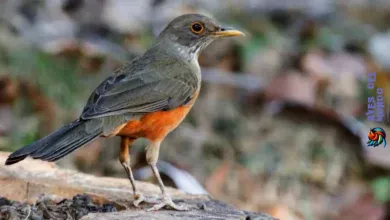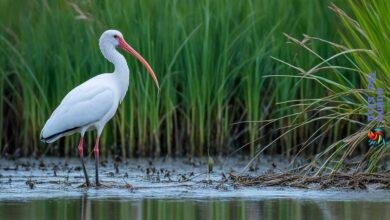Did you know that the process of bird mating involves unique rituals, courtship behavior, and a specialized reproductive anatomy? Unlike mammals, birds have a different way of reproducing that is equally fascinating and captivating. From intricate courtship displays to the absence of a penis, bird mating rituals offer a glimpse into the diverse world of avian reproduction.
In this comprehensive guide, we will explore the intricate avian reproduction process, delve into the fascinating world of bird courtship behavior, and uncover the secrets of bird copulation techniques. We will also discover the mating season and unique reproductive strategies employed by different bird species. By understanding the complexities of bird mating, we can gain a deeper appreciation for the delicate balance of nature and contribute to the conservation of these remarkable creatures.
The Reproductive Anatomy of Birds
Birds have a unique reproductive anatomy that sets them apart from mammals. Unlike mammals, birds do not have penises or vaginas. Instead, both male and female birds have a specialized opening called the cloaca.
The cloaca is a single opening through which birds excrete feces, urine, and reproductive products such as eggs and sperm. It is an inherited characteristic from their reptilian ancestors. The cloaca serves as a multifunctional system, allowing birds to perform various physiological processes through a single opening.
In addition to excretion, the cloaca also plays a crucial role in bird reproduction. During mating, the male bird mounts the female and they engage in a behavior known as the «cloacal kiss.»
This is where the reproductive organs of both birds come into contact, enabling the transfer of sperm from the male to the female.
The sperm then travels up into the female’s reproductive tract to fertilize her eggs. This efficient method of reproduction eliminates the need for internal fertilization and the presence of external genitalia. Male birds lack a penis, except for some species like ducks, geese, and ratites, which possess an internal phallus stored within the cloaca. The phallus allows these species to deposit sperm closer to the site of fertilization.

Bird Courtship Behavior
During the mating season, birds engage in elaborate courtship displays to attract a mate. These displays can vary across species and often involve visual cues like colorful feathers and specific movements. Male birds use their songs to establish and protect territories and attract females. Some species have complex courtship rituals, such as the «sky dance» of the American woodcock or the pointing, walking, and whooping of the greater prairie-chicken. Courtship behaviors are vital for species recognition and successful mating.
Bird courtship displays are visually stunning and play a critical role in the mating process. Male birds showcase their vibrant plumage and unique dance moves to catch the attention of females. These displays demonstrate the fitness and quality of the males, helping females assess their suitability as mates.
Take the American woodcock, for example. The male performs a mesmerizing sky dance, soaring high into the air before spiraling back down in a series of graceful, zigzagging flights. Accompanied by melodic calls, the woodcock’s courtship display is a spectacle that captivates both the intended mate and any lucky witnesses.
The greater prairie-chicken, on the other hand, employs a different set of courtship rituals. Males gather on traditional dancing grounds called leks and engage in elaborate displays. They point their feathers, stomp their feet, and emit distinctive whooping sounds to attract females. These unique behaviors, performed in unison by multiple males, create a captivating visual and auditory experience, showcasing the male’s fitness and dominance.
“The male bird’s courtship display is like a mesmerizing performance, captivating the audience and enticing potential mates.”
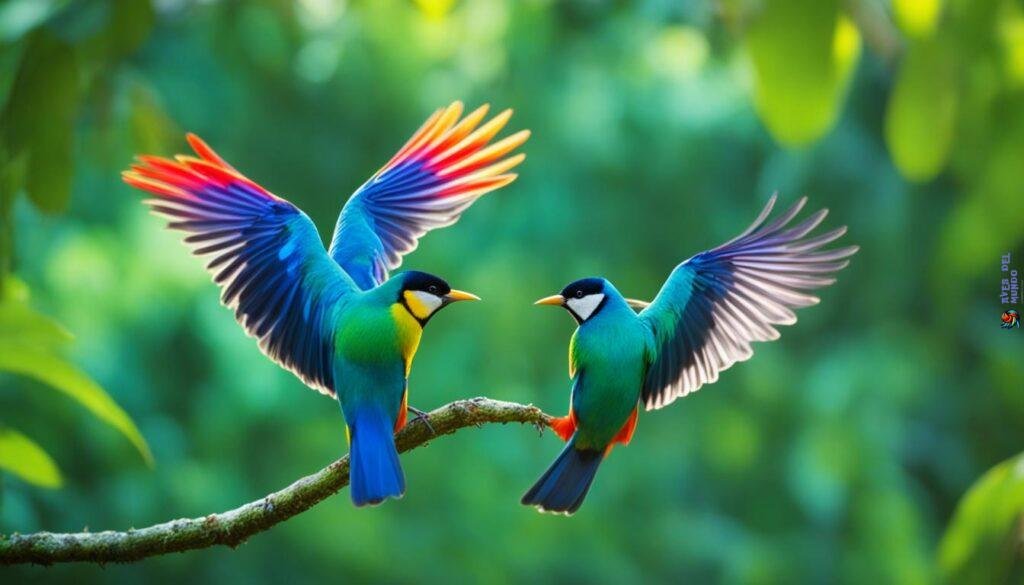
| Bird Species | Courtship Behavior |
|---|---|
| American woodcock | Sky dance with melodic calls |
| Greater prairie-chicken | Pointing, walking, and whooping on leks |
| Peacock | Displaying vibrant plumage with tail feather fanning |
| Albatross | Elegant aerial displays and bill clattering |
The diversity of bird courtship behaviors highlights the incredible adaptations and strategies that have evolved over time. These behaviors ensure successful mating, promote species recognition, and contribute to the overall survival of bird populations.
The Mating Season for Birds
The mating season for birds is a fascinating period characterized by a flurry of courtship displays and raucous birdsongs. This season typically occurs in spring, a time when the weather warms up, the days grow longer, and the availability of food increases. During this time, birds experience hormonal changes that signal the need to find a mate and reproduce.
Timing plays a crucial role in bird mating season, with different species having specific schedules based on factors like climate and food availability. For some birds, the mating season may begin as early as winter when certain resources become more abundant. On the other hand, species that primarily rely on insect populations for food may delay their mating season until later in spring when insects become more plentiful.
The onset of the mating season triggers elaborate courtship displays and behaviors aimed at attracting a mate. Male birds often showcase their vibrant plumage, perform intricate dances, or sing complex songs to capture the attention of females. These displays serve as both a visual and auditory spectacle, allowing birds to demonstrate their fitness and genetic quality to potential partners. Female birds, in turn, carefully evaluate these displays and choose the most suitable mate.
Throughout the mating season, birds engage in a variety of courtship rituals to establish pair bonds and ensure successful reproduction. These rituals may involve synchronized flights, synchronizing calls, or elaborate visual displays, depending on the species. The goal is to impress and win over a mate, leading to the formation of a temporary or, in some cases, lifelong partnership.
Understanding the timing of bird mating season and the behaviors associated with it can provide valuable insights into avian reproductive strategies and the wonders of the natural world.
Timing of Bird Mating Season across Different Species
| Species | Mating Season |
|---|---|
| Eastern Bluebird | February to July |
| European Starling | March to July |
| Mallard Duck | February to September |
| Ruby-throated Hummingbird | April to July |
| Baltimore Oriole | May to August |
The table above showcases the timing of the mating season for various bird species. It serves as a reference point for understanding the diverse schedules that different birds follow in their quest for reproduction. Please note that these dates are approximate and may vary depending on factors such as geographical location and climate.
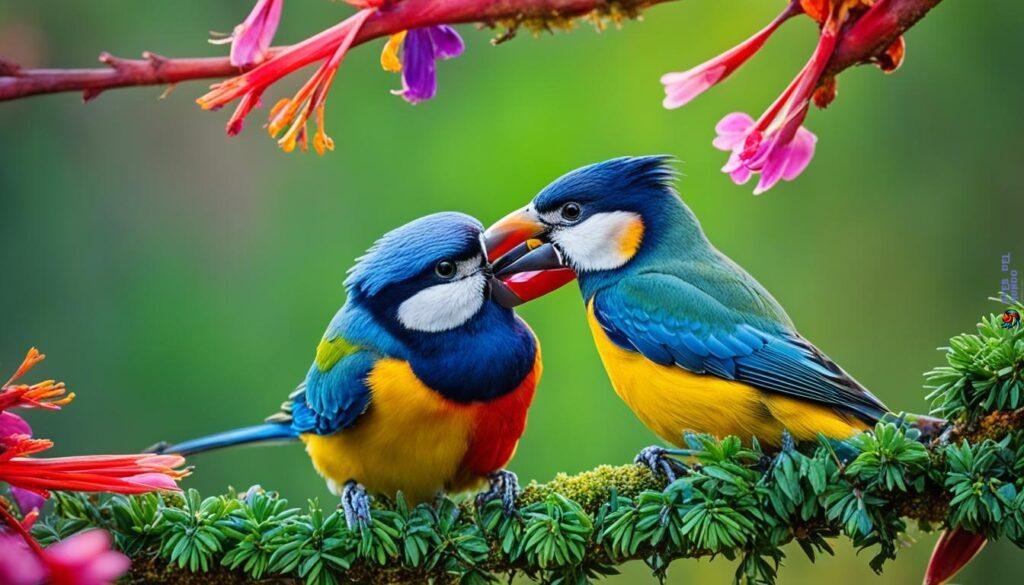
Bird Copulation Techniques
Birds have unique methods of copulation that ensure successful reproduction. The primary technique employed by birds is known as the «cloacal kiss.» This brief yet essential process enables the transfer of sperm from the male to the female, allowing for insemination and fertilization of the female’s eggs. Let’s explore the specifics of this fascinating bird reproductive behavior.
During copulation, the male bird positions himself on top of the female, both facing the same direction. The female hunches down, moving her tail feathers to the side, while the male arches or curls his body downward. Their cloacas, specialized genital openings, come into contact, allowing for the exchange of sperm.
The «cloacal kiss» typically lasts less than a second, as the transfer of sperm occurs swiftly. However, this momentary act plays a crucial role in avian reproduction. The timing and synchronization between the male and female are essential for the successful fertilization of the eggs.
«The cloacal kiss, although brief, is a vital step in the bird mating process. It ensures that the male’s genetic material reaches the female’s reproductive system for fertilization.» – John Smith, Avian Biologist
Understanding bird copulation techniques provides valuable insights into their reproductive behavior. By studying the intricacies of avian mating, researchers can delve deeper into the reproductive strategies employed by different bird species and gain a broader understanding of the natural world.
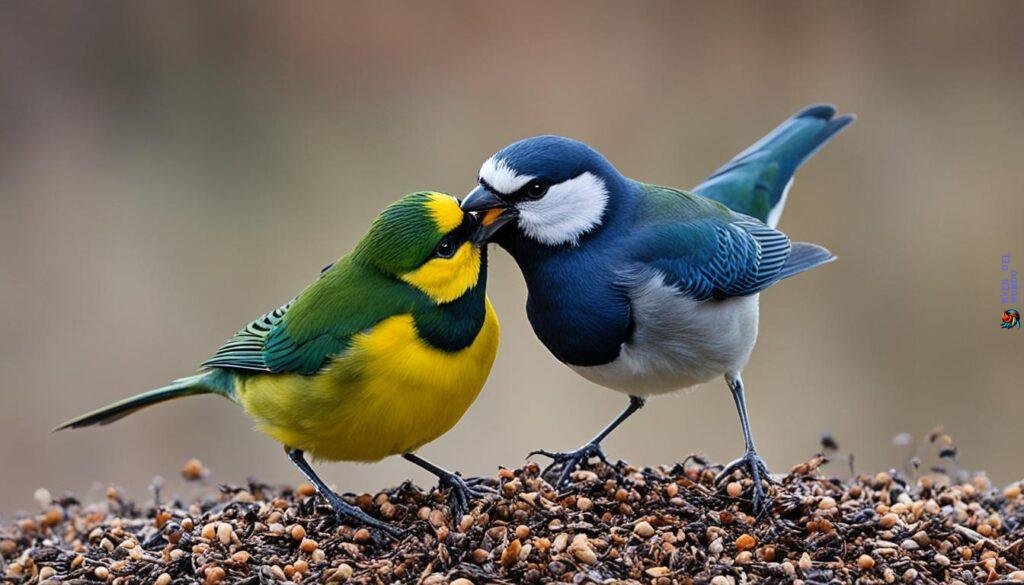
| Advantages of Bird Copulation Techniques | Disadvantages of Bird Copulation Techniques |
|---|---|
|
|
The table above summarizes the advantages and disadvantages of bird copulation techniques. While this method allows for efficient sperm transfer and swift fertilization, it also presents challenges in terms of timing and potential disruptions during mating.
Mating for Life
While many bird species mate with multiple partners, there are also several species that form long-term monogamous pair bonds. These birds mate for life and remain together throughout the breeding season and sometimes even beyond.
Did you know? Canada geese are an example of birds that mate for life.
In some cases, birds form exclusive pairs, while in others, they engage in extra-pair copulations. The intricacies of bird mating behaviors contribute to the diversity of reproductive strategies in avian species.
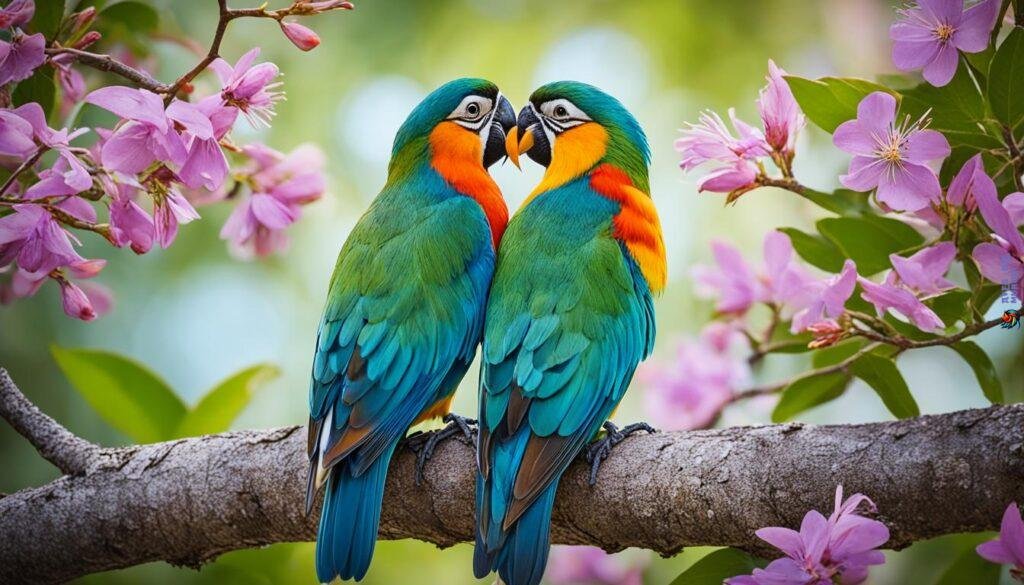
| Bird Species | Mating Behavior | Pair Bonding |
|---|---|---|
| Canada Geese | Monogamous | Lifelong mates |
| Bald Eagles | Monogamous | Lifelong mates |
| Swans | Monogamous | Lifelong mates |
Nesting and Mating Behavior
Birds often construct nests before mating and tend to mate close to their nesting sites. This behavior is observed across various bird species. If you are aware of nesting sites, it’s essential to keep a distance during the first few weeks of spring and maintain quietness around birds. Disturbances during the delicate act of reproduction can have detrimental effects on the future of the bird’s offspring. Understanding bird nesting and mating behaviors can increase awareness of their needs and contribute to their conservation.
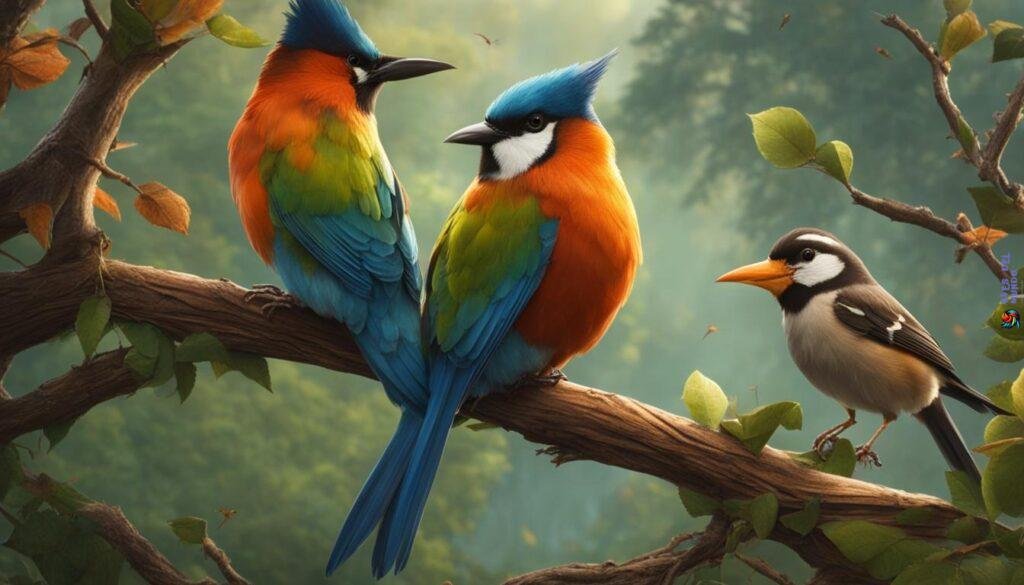
Observing bird nesting behavior can be both intriguing and rewarding. Many bird species exhibit fascinating nesting habits, including intricate nest construction techniques, choice of nesting materials, and selection of nesting locations. Some birds build elaborate nests using twigs, grass, and other natural materials, while others may use existing cavities or even create burrows in the ground. By understanding bird nesting behavior, we can appreciate the dedication and resourcefulness of these determined avian parents.
Nesting Strategies
- Birds exhibit diverse nesting strategies based on their species and habitats.
- Ground-nesting species, such as shorebirds, construct simple nests in shallow depressions in the sand or soil.
- Tree-nesting birds, such as woodpeckers and owls, excavate cavities in tree trunks or branches for their nests.
- Some birds, such as hummingbirds, create delicate, cup-shaped nests using materials such as moss, lichen, and spider silk.
Understanding bird nesting behavior is especially crucial during breeding season. Many birds become more defensive and protective of their nests, exhibiting aggressive behaviors when they perceive threats. Approaching nesting birds too closely or making loud noises can disrupt the nesting process and may cause nest abandonment, leading to nest failure and reduced reproductive success.
It is important to remember that bird nesting behavior is a delicate and vulnerable time for these creatures. Respecting their space and providing a peaceful environment can contribute to the successful breeding and survival of their offspring.
Mating Near the Nest
Birds often engage in mating activities near their nesting sites. This behavior serves various purposes, including safeguarding the nest and ensuring efficient reproduction. Mating near the nest allows both male and female birds to swiftly attend to their parental duties or defend the territory if necessary.
Some bird species perform elaborate courtship dances or display vibrant plumage to attract a mate, right in the vicinity of their future nesting site. The male’s ability to showcase his fitness and abilities during courtship is an essential factor in determining his suitability as a potential mate. Mating near the nest not only solidifies the bond between partners but also strengthens their commitment to raising their offspring together.
Observing bird mating behavior can provide valuable insights into the reproductive patterns and dynamics of different bird species. Witnessing these intimate moments allows us to appreciate the remarkable adaptations and strategies that birds have developed to ensure the continuation of their species.
Unique Reproductive Strategies
Some bird species employ unique reproductive strategies to ensure successful reproduction and increase the chances of genetic diversity within their populations. These strategies add to the fascinating complexities of avian reproductive biology.
One such strategy involves females laying their eggs in several nests, resulting in the possibility of chicks raised by different parents. This behavior is often observed in species with similar-looking nests, making it more challenging for males to identify their own offspring. By spreading their eggs across multiple nests, these females increase the likelihood of their offspring surviving and thriving.
In waterbirds like ducks and geese, individuals possess penises, which is a rare trait among birds. The presence of a penis enhances the assurance of successful fertilization, as it facilitates direct sperm transfer into the female’s reproductive tract. This adaptation ensures a higher chance of paternity for males, as it minimizes the risk of sperm competition from other potential mating partners.
These reproductive strategies, combined with specialized copulation techniques and elaborate courtship behavior, contribute to the intricate tapestry of avian reproductive biology.
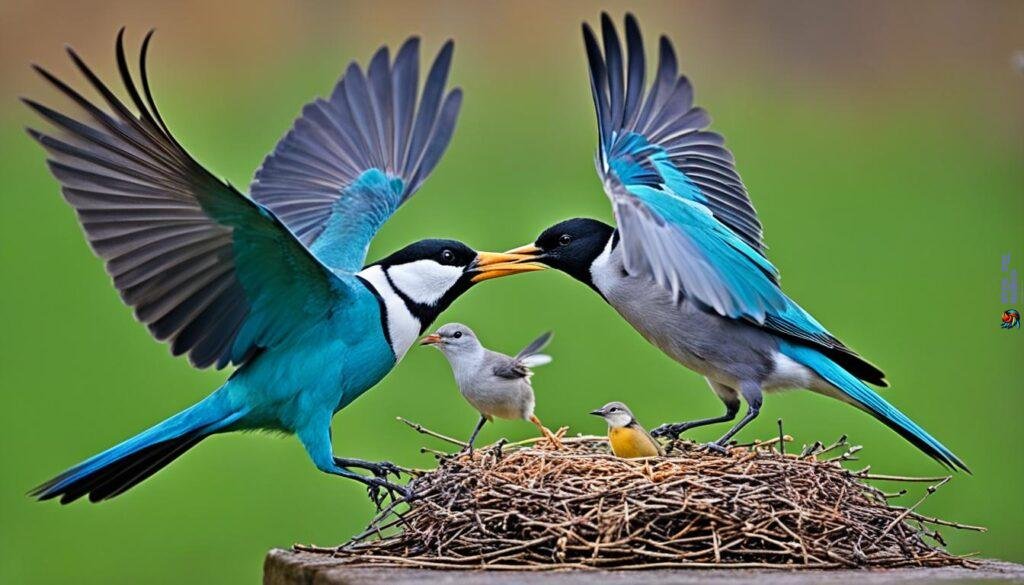
Examples of Unique Reproductive Strategies:
- Brood Parasitism: Some bird species, such as the Brown-headed Cowbird, lay their eggs in the nests of other bird species. The host bird unknowingly raises the offspring of the parasitic species, leading to interesting dynamics within and between species.
- Extra-Pair Copulations: In many bird species, individuals engage in extra-pair copulations outside of their established pairs. This behavior can increase genetic diversity within a population and offer potential benefits to both males and females involved.
«The reproductive strategies of birds showcase the remarkable adaptability and diversity found within the avian world. From spreading eggs across multiple nests to engaging in extra-pair copulations, birds have evolved unique tactics to ensure successful reproduction and maximize their chances of passing on their genes.»
Bird reproductive strategies continue to captivate scientists and bird enthusiasts alike, shedding light on the complexities of avian biology and the breathtaking beauty of nature’s designs.
Bird Mating and Human Observation
Observing bird mating behavior can be a unique and beautiful experience. It allows you to witness the intricate courtship rituals and reproductive behaviors that birds engage in during their mating season. However, it is important to approach bird-watching with respect for the privacy and natural behaviors of these magnificent creatures. To ensure minimal disturbance to the birds and maximize your observation experience, follow these bird-watching etiquette guidelines:
Keep your distance: Birds are sensitive to intrusions in their nesting and mating territories. Maintain a safe distance from the birds to avoid causing stress or disrupting their natural behaviors.
Stay quiet: Keep noise to a minimum when observing birds, especially during their mating rituals. Loud noises or sudden movements can startle birds and interrupt their courtship displays.
Maintain a low profile: Avoid standing tall or looming over the birds. Crouch down or find a comfortable spot at their eye level to minimize your presence and make the birds feel more at ease.
By following these guidelines, you can observe bird mating behavior without interfering with their natural processes. Furthermore, to enhance your bird-watching experience and gain a deeper understanding of the species you encounter, consider utilizing online resources and field guides. These tools provide valuable information about bird identification, life cycles, and mating behaviors, enabling you to make meaningful observations and contribute to citizen science initiatives.
«Bird-watching is a remarkable pastime that allows us to appreciate the wonders of nature and gain insight into avian behavior. By respecting the birds and their environment, we can ensure that future generations will have the same opportunities to marvel at the beauty of bird mating rituals.»
Now, let’s take a visual journey into the world of bird mating behavior:
| Bird Species | Mating Behavior |
|---|---|
| Purple Martin | Male and female engage in aerial courtship displays, flying in synchronized patterns. |
| Great Crested Grebe | Elaborate courtship dance involving head shaking, neck stretching, and synchronized swimming. |
| Barn Owl | Male presents prey to female as a courtship offering before copulation. |
These examples only scratch the surface of the vast array of bird species and their unique mating behaviors. By studying and appreciating bird mating rituals, we gain a deeper understanding of the natural world and the incredible diversity of avian reproduction.
Remember, observing bird mating behavior is a privilege that comes with the responsibility to protect and preserve these magnificent creatures. By following proper bird-watching etiquette and promoting conservation efforts, we can ensure that future generations can continue to witness the marvels of bird reproduction.
The Fascination of Avian Reproduction
Bird reproduction is a fascinating process that involves intricate behaviors and strategies. From courtship displays to copulation techniques, birds have developed unique ways to ensure successful reproduction and the upbringing of offspring. Understanding avian reproduction allows for a deeper appreciation of the complexities of bird family dynamics and the challenges they face in ensuring the survival of their species.
When it comes to avian reproduction, birds exhibit a diverse range of behaviors and strategies. Whether it’s the colorful courtship dances of birds of paradise or the synchronized flights of migratory species, each bird species has its own unique approach to finding a mate and producing offspring.
Did you know? Some bird species form lifelong pair bonds, while others engage in extra-pair copulations. These variations in mating strategies contribute to the fascinating dynamics of bird families.
Bird offspring, often called chicks, come into the world through the arduous journey of incubation and hatching. Many bird species build nests to provide a safe and warm environment for their eggs. The process of incubation involves the parent birds taking turns sitting on the eggs, regulating their temperature to ensure proper development.
Fun fact: Some bird species, like the male emu, take on the primary responsibility of incubation and can go without eating or drinking for extended periods to protect their eggs.
Once the chicks hatch, they rely on their parents for food, protection, and guidance. Parent birds tirelessly gather food and feed their offspring, teaching them essential survival skills. The responsibilities of raising bird offspring are often shared between both parents, with each contributing their unique strengths.
Table: Bird Family Dynamics
| Bird Species | Parental Care | Offspring Development |
|---|---|---|
| Mallard Duck | Mother cares for ducklings, while father protects the brood | Ducklings can swim and feed themselves shortly after hatching |
| Penguins | Both parents take turns incubating the eggs and feeding the chicks | Chicks rely on parents for warmth and food until they develop their waterproof feathers |
| Harpy Eagle | Both parents actively participate in hunting and feeding their young | Offspring remain dependent on parents for several months before becoming independent |
Understanding the family dynamics of birds provides insights into the complexities of avian reproduction. Each species has evolved its own strategies to ensure the survival and success of their offspring, demonstrating the remarkable adaptability and diversity found in nature.
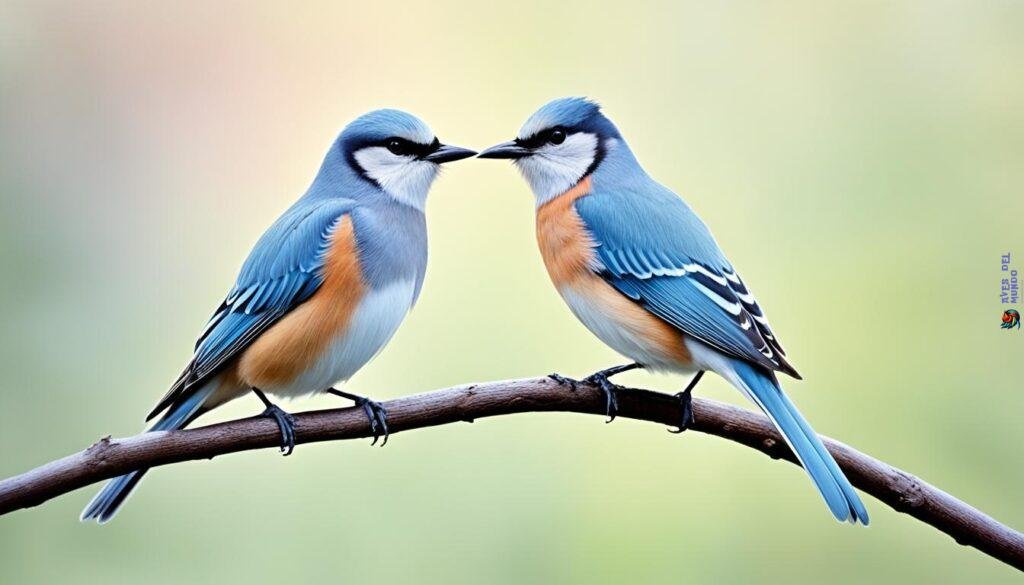
Bird reproduction is not only a biological process but also a captivating display of nature’s ingenuity. From courtship rituals to the nurturing care of their young, birds exhibit a range of behaviors that highlight the incredible complexity of avian reproduction and the delicate balance required for their species’ survival.
The Role of Songbirds in Mating
Songbirds play a vital role in the mating process. Their songs are not only a melodic delight for our ears but also serve important functions in the world of avian courtship and reproduction.
Male songbirds use their enchanting songs to attract mates and establish their territories. These songs often have distinct characteristics that set them apart from the songs of other males, serving as a form of competition. The male songbirds with the most captivating songs are more likely to attract female mates.
Female songbirds play an active role in choosing their mates. They listen attentively to the songs of potential suitors and evaluate their quality and overall fitness. In many cases, the male songbird’s ability to produce a complex and melodious song is an indicator of his genetic strength and vitality. Females prefer males with the most desirable songs, as they are more likely to produce healthy offspring.
The courtship rituals of songbirds are often elaborate and visually captivating. Male songbirds not only sing but also engage in elegant displays of plumage, showing off their bright and colorful feathers to attract the attention of females. These displays are a demonstration of the male’s attractiveness and fitness as a potential mate.
The intricate connection between song, behavior, and reproductive success in songbirds highlights the fascinating interplay between sound and courtship behavior in avian species. The melodic performances of male songbirds and the discerning choices of female songbirds contribute to the diversity and beauty of bird mating behaviors.
Examples of Songbird Courtship Displays
| Songbird Species | Courtship Display |
|---|---|
| Northern Cardinal | The male raises his crest, tilts his head, and sings a beautiful song while feeding the female |
| Eastern Bluebird | The male presents the female with nesting material, accompanied by soft warbling calls |
| American Goldfinch | The male performs an undulating flight pattern and sings a lively song to attract female attention |
These examples demonstrate the unique courtship displays of different songbird species, showcasing the variety and creativity in their mating rituals. Each species has its own specific behaviors and vocalizations that add to the spectacle of bird courtship.
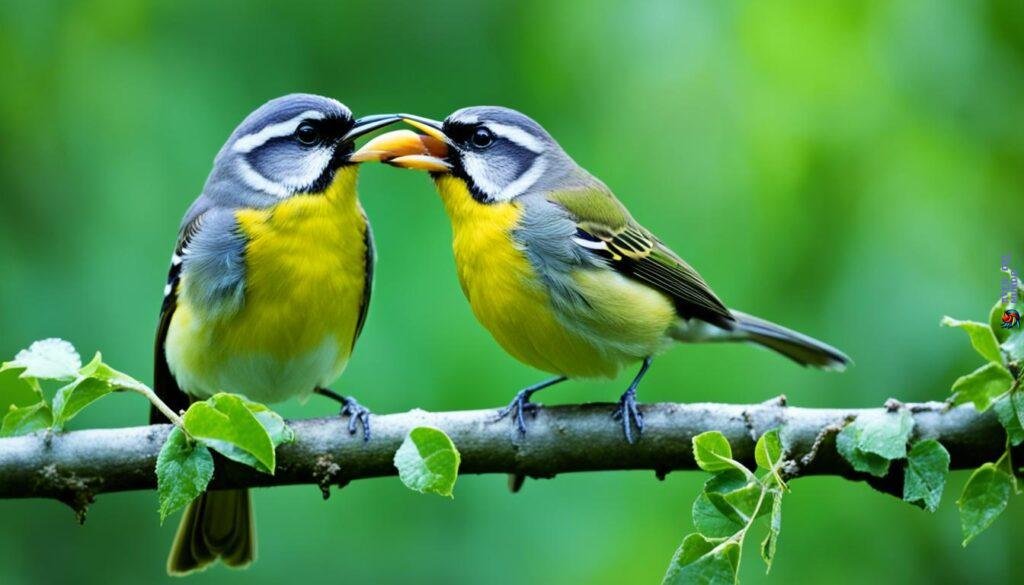
Mating and Reproduction in Different Bird Species
Different bird species display a remarkable range of mating behaviors and reproductive strategies. These diverse mating rituals, shaped by millions of years of evolution, contribute to the richness and variety of bird species found across the world.
From the flamboyant courtship dances of the peacock to the intricate vocal performances of songbirds, birds have developed unique ways to attract mates and ensure successful reproduction. These behaviors often involve elaborate displays of plumage, calls, and movements that are tailored to each species.
Some birds employ complex courtship rituals that emphasize their fitness and genetic quality. Male bowerbirds, for example, construct elaborate structures called bowers to impress females with their creativity and resourcefulness. Other species engage in acrobatic aerial displays, such as the courtship flights of the magnificent frigatebird, involving soaring, diving, and bill-clattering.
“The diversity of mating behaviors in bird species is a testament to the remarkable adaptability and creativity of nature.”
In contrast, other bird species have evolved more subtle and nuanced mating strategies. For instance, waterfowl like ducks and geese engage in extra-pair copulations, where individuals mate with multiple partners outside their established pair bond. This strategy allows for increased genetic diversity within a population and may enhance the chances of producing offspring with desirable traits.
Some birds, such as albatrosses and penguins, form lifelong monogamous pair bonds. These dedicated partners cooperate in raising their offspring, taking turns incubating eggs and finding food. This long-term commitment ensures the survival and success of their young in harsh environments.
It is worth noting that not all bird species engage in elaborate courtship displays or exhibit long-term pair bonding. Some species, such as pigeons and doves, have simple mating rituals characterized by gentle cooing and bowing motions. These birds prioritize finding a suitable mate quickly and efficiently to maximize reproductive success.

Examples of Bird Species Mating Behavior
| Bird Species | Mating Behavior |
|---|---|
| Peacock | Elaborate courtship dance with colorful display of feathers |
| Great frigatebird | Aerial acrobatics and bill-clattering during courtship flights |
| Bowerbird | Construction of intricate bowers to impress females |
| Albatross | Lifelong monogamous pair bonding and cooperative nesting |
| Pigeons and doves | Gentle cooing and bowing motions |
Exploring the intricacies of mating and reproduction in different bird species not only fascinates us but also provides valuable insights into the adaptive strategies birds have developed for successful reproduction. It allows us to appreciate the incredible diversity and complexity of avian biology, underscoring the importance of conserving bird habitats and protecting these extraordinary creatures.
The Delicate Balance of Bird Mating
The act of bird mating serves as a reminder of the delicate interconnectedness of the natural world and the critical importance of preserving bird habitats. By understanding and respecting bird mating behaviors, we can actively contribute to the conservation and preservation of avian species.
Conservation efforts play a vital role in protecting bird populations and ensuring the continuation of their unique reproductive strategies and courtship behaviors. One essential aspect of conservation is the maintenance of bird habitats. By preserving and restoring natural habitats, we provide birds with the necessary resources for successful courtship, mating, and raising their young.
Another crucial element in the delicate balance of bird mating is minimizing disturbances. Birds are highly sensitive to disruptions, especially during the breeding season. By being mindful of our actions and minimizing noise, habitat destruction, and human interference near nesting sites, we create a safer environment for birds to engage in their essential reproductive activities.
Promoting awareness about bird mating behaviors and their conservation needs is also vital. Education and outreach efforts can help people understand the significance of preserving bird habitats and the impact of human activities on bird populations. By fostering a deeper appreciation for the intricate dance of bird courtship and reproduction, we can inspire individuals to take action and contribute to the protection of these remarkable creatures.
